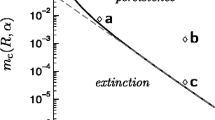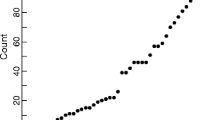Abstract
Isolated populations or those at the edge of their distribution are usually more sensitive to changes in the environment, such as climate change. For the barnacle Semibalanus balanoides (L.), one possible effect of climate change is that unpredictable spring weather could lead to the mismatching of larval release with spring phytoplankton bloom, hence reducing the recruitment. In this paper, model simulations of a variable open population with space limited recruitment were used to investigate the effects of low and zero recruitment on population abundance in S. balanoides. Data for model parameters was taken from an isolated population in the Isle of Man, British Isles. Model simulations with observed frequencies of years with low recruitment showed only small changes in population dynamics. Increased frequencies of low recruitment had large effects on the variation in population growth rate and free space and on population structure. Furthermore, populations with intermediate to high frequencies of low recruitment appeared more sensitive to additional changes in recruitment. Exchanging low recruitment with zero recruitment severely increased the risk of local extinctions. Simulations with consecutive years of low recruitment showed a substantial increase in free space and an increase in the time taken to recover to normal densities. In conclusion, model simulations indicate that variable populations can be well buffered to changes in the demography caused by introduced environmental noise, but also, that intermediate to high frequencies of disturbance can lead to a swift change in population dynamics, which in turn, may affect the dynamics of whole communities.





Similar content being viewed by others
References
Åberg P (1992) A demographic study of two populations of the seaweed Ascophyllum nodusum. Ecology 73:1473–1487
Barnes H (1953) The effect of lowered salinity on some barnacle nauplii. J Anim Ecol 22:328–330
Barnes H (1956) Balanus balanoides (L.) in the Firth of Clyde: the development and annual variation of the larval population, and the causative factors. J Anim Ecol 25:72–84
Barnes H (1957a) The Northern limits of Balanus balanoides (L.). Oikos 8:1–15
Barnes H (1957b) Processes of restoration and synchronisation in marine ecology. The spring diatom outburst and the “spawning” of the common barnacle Balanus balanoides (L.). Ann Biol 33:67–85
Barnes H (1958) The Southern limits of Balanus balanoides (L.). Oikos 9:139–157
Barnes H (1962) Notes on variations in the release of nauplii of Balanus balanoides with special reference to the spring diatom outburst. Crustaceana 4:118–122
Barnes H (1963) Light, temperature and the breeding of Balanus balanoides. J Mar Biol Assoc UK 43:213–223
Barnes H, Barnes M (1965) Egg size, nauplius size, and their variation with local, geographical, and specific factors in some common cirripedes. J Anim Ecol 34:391–402
Beaugrand G, Reid PC (2003) Long-term changes in phytoplankton, zooplankton and salmon related to climate. Global Change Biol 9:801–817
Beaugrand G, Reid PC, Ibanes F, Lindley JA, Edwards M (2002) Reorganization of North Atlantic marine copepod biodiversity and climate. Science 296:1692–1694
Belgrano A, Lindahl O, Hernroth B (1998) North Atlantic Oscillation primary productivity and toxic phytoplankton in the Gullmar Fjord, Sweden (1985–1996). Proc R Soc London 266:425–430
Caley MJ, Hughes TP, Jones GP, Carr MH, Hixon MA, Menge BA (1996) Recruitment and the local dynamics of open marine populations. Annu Rev Ecol Syst 27:477–500
Caswell H (2000) Matrix Population Models, 2nd edn. Sinauer Associates, Sunderland
Clarke A, Harris CM (2003) Polar marine ecosystems: major threats and future change. Environ Conserv 30:1–25
Cohen JE (1987) Stochastic demography. Enc Stat Sci 8:789–801
Connell JH (1961) Effects of competition, predation by Thais lapillus, and other factors on natural populations of the barnacle, Balanus balanoides (L.). Ecol Monogr 31:61–104
Crisp DJ, Clegg DJ (1960) The induction of the breeding condition in Balanus balanoides (L.). Oikos 11:265–276
Crisp DJ, Southward AJ (1958) The distribution of intertidal organisms along the coasts of the English Channel. J Mar Biol Assoc UK 37:157–208
Cushing DH (1990) Plankton production and year-class strength in fish populations—an update of the match mismatch hypothesis. Adv Mar Biol 26:249–293
Dippner JW (1997) Recruitment success of different fish stocks in the North Sea in relation to climate variability. Dtsch Hydrograph Z 49:277–293
Edwards M, Beugrand G, Reid PC, Ashley AR, Jones MB (2002) Ocean climate anomalies and the ecology of the North Sea. Mar Ecol Prog Ser 239:1–10
Fromentin J-M, Planque B (1996) Calanus and environment in the North Atlantic. II. Influence of the North Atlantic Oscillation on C. finmarchicus and C. helgolandicus. Mar Ecol Progr Ser 134:111–118
Hartnoll RG, Hawkins SJ (1985) Patchiness and fluctuations on moderately exposed shores. Ophelia 24:53–64
Hawkins SJ (1983) Interactions of patella and macroalgae with settling Semibalanus balanoides. J Exp Mar Biol Ecol 71:55–72
Hawkins SJ, Hartnoll RG (1982) Settlement patterns of Balanus balanoides (L.) in the Isle of Man (1977–1981). J Exp Mar Biol Ecol 62:271–283
Hawkins SJ, Hartnoll RG, Kain JM, Norton TA (1992) Plant-animal interactions on hard substrata in the north-east Atlantic. In: John DM, Hawkins SJ, Price JH (eds) Plant–animal interactions in the marine benthos. Clarendon Press, Oxford, p 570
Heyde CC, Cohen JE (1985) Confidence intervals for demographic projections based on products of random matrices. Theor Popul Biol 27:120–153
Hills JM, Thomason JC (2003) The ‘ghost of settlement past determines mortality and fecundity in the barnacle, Semibalanus balanoides. Oikos 101:529–538
Hills JM, Thomason JC, Milligan JL, Richardson M (1998) Do barnacle larvae respond to multiple settlement cues over a range of spatial scales. Hydrobiologia 375/376:101–111
Hodkinson ID (1999) Species response to global environmental change or why ecophysiological models are important: a reply to Davis et al. J Anim Ecol 68:1259–1262
Hughes TP, Baird AH, Dinsdale EA, Moltschaniwskyj NA, Pratchett MS, Tanner JE, Willis BL (2000) Supply-side ecology works both ways: the link between benthic adults, fecundity, and larval recruits. Ecology 81:2241–2249
Hyder K, Åberg P, Johnson MP, Hawkins SJ (2001) Models of open populations with space limited recruitment: extension of theory and application to the barnacle Chthamalus montagui. J Anim Ecol 70:853–863
Jenkins SR, Hawkins SJ (2003) Barnacle larval supply to sheltered rocky shores: a limiting factor? Hydrobiologia 503:143–151
Jenkins SR, Norton TA, Hawkins SJ (1999) Settlement and post-settlement interactions between Semibalanus balanoides (L.) (Crustacea: Cirripedia) and three species of fucoid canopy algae. J Exp Mar Biol Ecol 236:49–67
Jenkins SR, Åberg P, Cervin G, Coleman RA, Delany J, Della Santina P, Hawkins SJ, LaCroix E, Myers AA, Lindegarth M, Power AM, Roberts MF, Hartnoll RG (2000) Spatial and temporal variation in settlement and recruitment of the intertidal barnacle Semibalanus balanoides (L.) (Crustacea: Cirripedia) over a European scale. J Exp Mar Biol Ecol 243:209–225
Jenkins SR, Åberg P, Cervin G, Coleman RA, Delany J, Hawkins SJ, Hyder K, Myers AA, Paula J, Power AM, Range P, Hartnoll RG (2001) Population dynamics of the intertidal barnacle Semibalanus balanoides at three European locations: spatial scales of variability. Mar Ecol Progr Ser 217:207–217
Kaitala V, Ranta E (2001) Is the impact of environmental noise visible in the dynamics of age-structured populations? Proc R Soc London 268:1769–1774
Kendall ME, Bowman RS, Williamson P, Lewis JR (1982) Settlement patterns, density and stability in the barnacle Balanus balanoides. Neth J Sea Res 16:119–126
Kendall ME, Bowman RS, Williamson P, Lewis JR (1985) Annual variation in the recruitment of Semibalanus balanoides on the North Yorkshire coast. J Mar Biol Assoc UK 65:1009–1030
King PA, McGrath D, Morgan R, Fitzgerald O, Mullins P, Raleigh J (1993) Reproduction and settlement of the barnacle Semibalanus Balnoides (L.) in Galway Bay. Proc R Ir Acad 93B:5–12
Knight-Jones EW (1953) Laboratory experiments on gregariousness during settling in Balanus balanoides and other barnacles. J Exp Biol 30:584–598
Kröncke I, Dippner JW, Heyen H, Zeiss B (1998) Long-term changes in macrofaunal communities off Norderney (East Frisia, Germany) in relation to climate variability. Mar Ecol Progr Ser 167:25–36
Lande R (1993) Risks of population extinction from demographic and environmental stochasticity and random catastrophes. Am Nat 142:911–927
Lewis JR, Bowman RS (1975) Local habitat induced variations in the population dynamics of Patella vulgata (L). J Exp Mar Biol Ecol 17:165–203
Lewis JR, Bowman RS, Kendall MA, Williamson PA (1982) Some geographical components in population dynamics: possibilities and realities in some littoral species. Neth J Sea Res 16:18–28
Lindley JA, Reid PC (2002) Variations in the abundance of Centropages typicus and Calanus helgolandicus in the North Sea: deviations from close relationships with temperature. Mar Biol 141:153–165
Lundberg P, Ranta E, Ripa J, Kaitala V (2000) Population viability in space and time. Trends Ecol Evol 15:460–464
Menge BA (2000) Recruitment vs. postrecruitment processes as determinants of barnacle population abundance. Ecol Monogr 70:265–288
Minchinton TE, Scheibling RE (1991) The influence of larval supply and settlement on the population structure of barnacles. Ecology 72:1867–1879
Muko S, Sakai K, Iwasa Y (2001) Size distribution dynamics for a marine sessile organism with space limited recruitment: application to a coral population. J Anim Ecol 70:579–589
Nakaoka M (1996) Dynamics of age- and size-structured populations in fluctuating environments: applications of stochastic matrix models to natural populations. Res Popul Ecol 38:141–152
Parmesan C, Yohe G (2003) A globally coherent fingerprint of climate change impacts across natural systems. Nature 421:37–42
Reid PC, Holliday NP, Smyth TJ (2001) Pulses in the eastern margin current and warmer water off the north west European shelf linked to North Sea ecosystem changes. Mar Ecol Progr Ser 215:283–287
Ripa J, Lundberg P (1996) Noise colour and the risk of population extinctions. Proc R Soc London Ser B 263:1751–1753
Ripa J, Lundberg P (2000) The route to extinction in variable environments. Oikos 90:89–96
Southward AJ (1953) The ecology of some rocky shores in the south of the Isle of Man. Proc Trans Liverpool Biol Soc 59:1–50
Southward AJ (1967) Recent changes in the abundance of intertidal barnacles in southwest England, a possible effect of climate deterioration. J Mar Biol Assoc UK 47:81–95
Southward AJ (1991) Forty years of changes in species composition and population-density of barnacles on a rocky shore near Plymouth. J Mar Biol Assoc UK 71:495–523
Svensson CJ, Jenkins SR, Hawkins SJ, Myers AA, Range P, Paula J, O’Riordan R, Åberg P (2004) Models of open populations with space-limited recruitment in stochastic environments: the relative importance of recruitment and survival in populations of Semibalanus balanoides. Mar Ecol Progr Ser 275:185–197
Thomas CD, Cameron A, Green RE, Bakkenes M, Beaumont LJ, Collingham YC,Erasmus BFN, de Siqueira MF, Grainger A, Hannah L, Hughes L, Huntley B, van Jaarsveld AS, Midgley GF, Miles L, Ortega-Huerta MA, Peterson AT, Philips OL, Williams SE (2004) Extinction risk from climate change. Nature 427:145–148
Thorson G (1950) Reproduction and larval ecology of marine bottom invertebrates. Biol Rev 25:1–45
Tilman D, Lehman C (2001) Human-caused environmental change: Impacts on plant diversity and evolution. Proc Natl Acad Sci USA 98:5433–5440
Tuljapurkar SD (1990) Population dynamics in variable environments. Springer, Berlin Heidelberg New York
Tuljapurkar SD, Caswell H (1997) Structured population models in marine, terrestrial and freshwater systems, 1st edn. Chapman and Hall, New York
Tunberg BG, Nelson WG (1998) Do climatic oscillation influence cyclical patterns of soft bottom macrobenthic communities on the Swedish west coast? Mar Ecol Progr Ser 170:85–94
Vitousek PM (1994) Beyond global warming: ecology and global change. Ecology 75:1861–1876
Weaver AJ, Eby M, Wiebe EC, Bitz CM, Duffy PB, Ewen TL, Fanning AF, Holland MM, Macfadyen A, Matthews HD, Meissner KJ, Saenko O, Scmittner A, Wang HX, Yoshimori M (2001) Yhe UVic system model: model description, climatology, and appplications to past, present and future climates. Atmosphere-Ocean 39:361–428
Wetherald RT, Stouffer RJ, Dixon KW (2001) Committed warming and implications for climate change. Geophys Res Lett 28:1535–1538
Acknowledgements
This study was performed as a part of the project EUMAR (EU EVK3-CT-2001-00048). Data were attained from EUROROCK (EU MAS3-CT95-0012) and we would like to thank Pedro Range for analysing the photographs.
Author information
Authors and Affiliations
Corresponding author
Rights and permissions
About this article
Cite this article
Svensson, C.J., Jenkins, S.R., Hawkins, S.J. et al. Population resistance to climate change: modelling the effects of low recruitment in open populations. Oecologia 142, 117–126 (2005). https://doi.org/10.1007/s00442-004-1703-3
Received:
Accepted:
Published:
Issue Date:
DOI: https://doi.org/10.1007/s00442-004-1703-3




